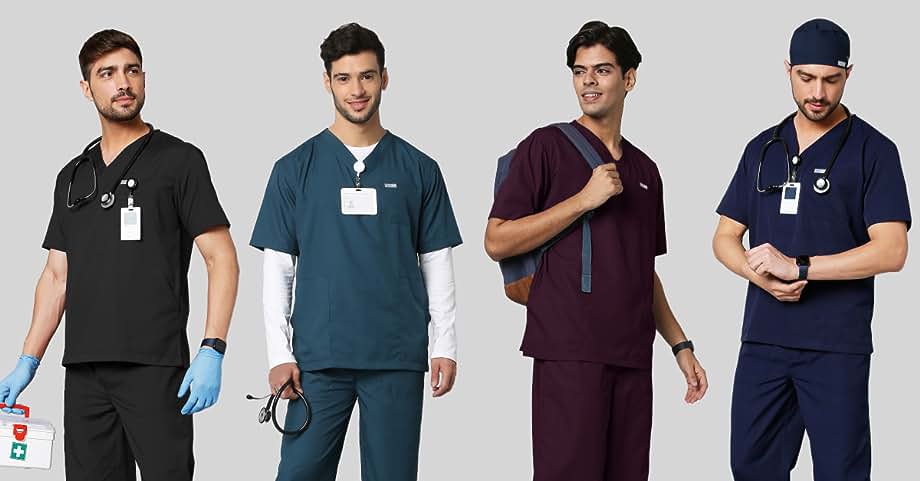Health care UNIFORMS

Hygiene and Infection Control

Prevents Cross-Contamination: Healthcare uniforms are specifically designed to reduce the risk of infection transmission between patients and healthcare workers. By wearing uniforms made from materials that are easy to disinfect and launder, healthcare workers prevent the spread of harmful bacteria, viruses, and other pathogens that could cause hospital-acquired infections (HAIs).
Protection Against Contaminants: Healthcare workers often come into contact with bodily fluids, blood, and other contaminants. Uniforms, such as scrubs, are designed to protect workers from exposure to these materials, which helps maintain both their health and the cleanliness of the healthcare environment.
Safety and Protection

Physical Protection: Healthcare uniforms are designed to provide a basic level of protection against physical hazards. For example, scrubs can help prevent contact with harmful substances or fluids during procedures. In certain healthcare settings, uniforms are designed to be resistant to spills and stains, further reducing exposure to potentially hazardous materials.
Personal Protective Equipment (PPE): Healthcare uniforms often work in tandem with personal protective equipment (PPE) such as gloves, masks, and gowns to ensure that healthcare workers are fully protected. These uniforms are an integral part of a healthcare worker’s PPE, especially in situations where there is a risk of exposure to infectious agents.


Professionalism and Trust

Creating a Professional Image: Uniforms in healthcare settings help convey a professional and competent image. When patients and their families see healthcare workers dressed in clean, standardized uniforms, it builds trust and confidence in the care they are receiving. A professional appearance contributes to the credibility of the healthcare institution and enhances the public perception of the workers’ roles
Promotes Authority and Respect: Healthcare uniforms help distinguish medical professionals from patients, making it easier for patients and visitors to identify who is in charge of their care. This visual distinction is important for both practical and psychological reasons—patients often feel more at ease when they can easily identify healthcare professionals.
Identification and Role Clarity

Clear Role Identification: Healthcare uniforms make it easy for patients, visitors, and fellow staff members to identify the roles and responsibilities of each healthcare worker. For example, nurses, doctors, surgeons, and other medical staff may wear different types of uniforms or color-coded scrubs, allowing for quick identification in a busy hospital environment.
Quick Response in Emergencies: In emergency situations, clear identification of healthcare workers is essential. The uniform helps staff members and patients identify who can provide assistance, especially in fast-paced environments like emergency rooms or intensive care units (ICUs).


Comfort and Practicality

Comfort During Long Shifts: Healthcare workers often have to work long hours, sometimes in physically demanding or high-stress environments. Healthcare uniforms are designed to be comfortable, allowing workers to move freely, which is essential for performing various tasks, from assisting patients to performing medical procedures.
Functionality for Healthcare Tasks: Healthcare uniforms often feature practical elements such as pockets, which allow medical professionals to carry essential tools like pens, notepads, and stethoscopes. Scrubs and lab coats are designed to be practical and functional, enabling staff to work efficiently without being hindered by their clothing.
Preventing the Spread of Infections

Minimizing External Contamination: Healthcare environments are high-risk areas for infections. Wearing uniforms helps to minimize the possibility of carrying external contaminants into patient areas. Clean, standardized uniforms ensure that healthcare workers don’t bring in germs from the outside world, thereby maintaining a sterile and safe environment.
Easy to Launder: Healthcare uniforms are typically made from fabrics that can be easily washed at high temperatures to eliminate pathogens. This regular laundering is a critical component of infection control in hospitals, clinics, and other healthcare settings.


Uniformity and Team Spirit

Fosters Teamwork and Cohesion: Wearing the same or similar uniforms helps foster a sense of unity and belonging among healthcare workers. This can strengthen the teamwork needed to provide quality care, as everyone feels part of the same organization or goal.
Reduces Distractions and Personal Bias: A uniform dress code removes any distinctions that might arise from personal fashion choices, reducing potential distractions and biases. It promotes equality, as all staff is dressed similarly, regardless of their personal financial or social background.
Patient Comfort and Confidence

Patients Feel Safe and Comfortable: Healthcare uniforms help patients feel more comfortable and secure in a medical setting. Knowing that the staff is easily identifiable in their uniforms can reduce anxiety, particularly for patients who are in unfamiliar or stressful situations, like undergoing surgery or being admitted to the hospital.
Satisfaction and Trust: Uniforms help create a standard of cleanliness and professionalism, contributing to a positive overall patient experience. Patients are more likely to trust their caregivers when they see them wearing appropriate, clean, and professional attire.


Compliance with Health and Safety Regulations

Meets Industry Standards: Healthcare settings are subject to strict health and safety regulations that require uniforms to meet specific standards. Healthcare uniforms help hospitals, clinics, and other institutions comply with these regulations, which may include infection control guidelines and the use of appropriate PPE.
Ensures Standardized Protocols: Healthcare uniforms are part of a hospital’s infection control protocols. By ensuring that all workers wear appropriate, clean uniforms, healthcare providers can meet legal and regulatory requirements related to hygiene and safety.
Cost-Effectiveness and Time-Saving

Simplifies Wardrobe Choices: Healthcare uniforms standardize what workers need to wear, reducing the decision-making process regarding clothing choices each day. This saves time and energy, allowing healthcare workers to focus on patient care rather than worrying about what to wear.
Reduces Clothing Costs for Workers: Providing healthcare uniforms or requiring standardized uniforms helps reduce the financial burden on employees, as they don’t need to purchase a full wardrobe for work. The cost of maintaining and replacing uniforms is typically borne by the healthcare facility.

